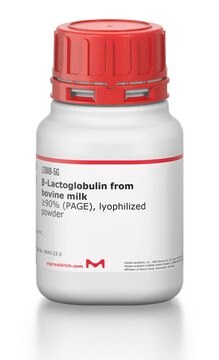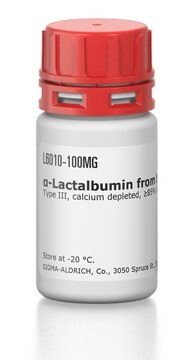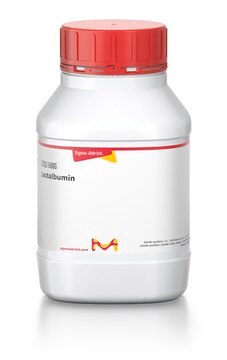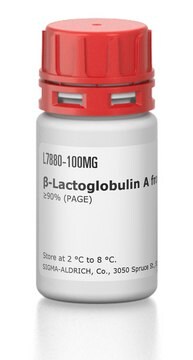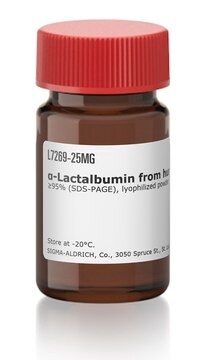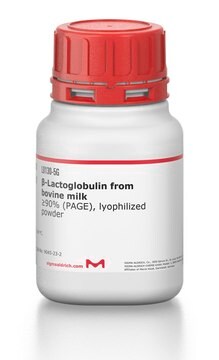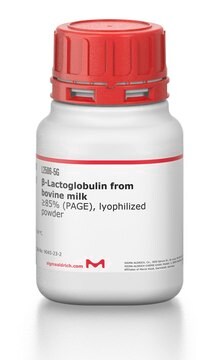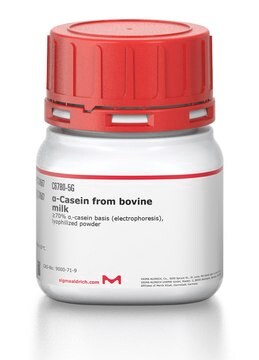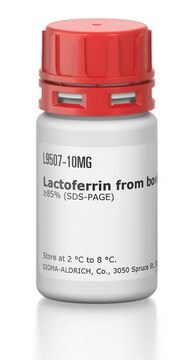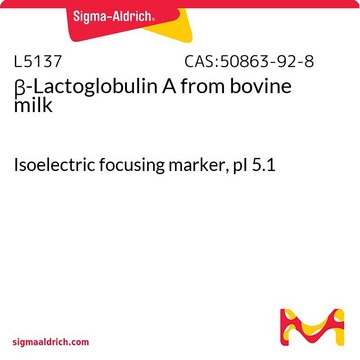L5385
α-Lactalbumin from bovine milk
Type I, ≥85% (PAGE), lyophilized powder
Synonym(s):
Bos d 4, Lactose synthase B protein, alpha-lactalbumin
Sign Into View Organizational & Contract Pricing
All Photos(4)
About This Item
Recommended Products
biological source
bovine milk
Quality Level
type
Type I
Assay
≥85% (PAGE)
form
lyophilized powder
concentration
≥85 % protein
technique(s)
cell culture | mammalian: suitable
electrophoresis: suitable
impurities
calcium, tested
solubility
H2O: soluble 10 mg/mL, clear to slightly hazy, colorless to faintly yellow
UniProt accession no.
storage temp.
−20°C
Gene Information
cow ... LALBA(281894)
Looking for similar products? Visit Product Comparison Guide
General description
α-Lactalbumin is a small, globular, whey protein that has been found in all milk studied to date. It is a metalloprotein of approximately 14 kDa produced in the mammary glands.
Application
α-Lactalbumin from bovine milk has been used as a supplement of basal medium for various cell cultures. It has also been used as a marker for sodium dodecyl sulfate-polyacrylamide gel electrophoresis (SDS-PAGE).
Biochem/physiol Actions
α-Lactalbumin is the cheif protein in human milk. It consists of a single polypeptide chain with 8 cysteines which form disulfide bridges. α-Lactalbumin binds several metal ions, including calcium, which is thought to play a role in the regeneration of native α-lactalbumin from the reduced, denatured form. α-Lactalbumin also has a distinct zinc binding site that is thought to play a role in the binding of the lactose synthase complex. The mature protein consists of 123 amino acid residues (14 kD), and it has a three-dimensional structure with 1.7 Α° resolution, demonstrating four α-helices and a triple stranded antiparallel β-sheet.
Alters the substrate specificity of galactosyltransferase to increase the rate of lactose formation; the complex of galactosyltransferase and α-lactalbumin is called lactose synthase.
Alters the substrate specificity of galactosyltransferase to increase the rate of lactose formation; the complex of galactosyltransferase and α-lactalbumin is called lactose synthase. Site-directed mutagenesis of Asp87 or Asp88 to Ala completely abolishes the strong calcium binding affinity and reduces the stimulation of lactose synthase to <3.5% of the maximal rate.
Quality
Calcium saturated. May have traces of ammonium sulfate and sodium phosphate
Storage Class Code
11 - Combustible Solids
WGK
WGK 3
Flash Point(F)
Not applicable
Flash Point(C)
Not applicable
Personal Protective Equipment
dust mask type N95 (US), Eyeshields, Gloves
Choose from one of the most recent versions:
Already Own This Product?
Find documentation for the products that you have recently purchased in the Document Library.
Customers Also Viewed
Falk Bernsmann et al.
Journal of colloid and interface science, 344(1), 54-60 (2010-01-23)
We recently showed the possibility to build dopamine-melanin films of controlled thickness by successive immersions of a substrate in alkaline solutions of dopamine [F. Bernsmann, A. Ponche, C. Ringwald, J. Hemmerlé, J. Raya, B. Bechinger, J.-C. Voegel, P. Schaaf, V.
Effect of different exogenous fatty acids on the cytosolic triacylglycerol content in bovine mammary cells
Vargas-Bello-Perez E, et al.
Animal Nutrition, 5(2), 202-208 (2019)
Identification of Mannose-Binding Protein from Milkfish (Chanos chanos F.) Serum
Argayosa AM, et al.
Journal of Mathematics, 6(3) (2019)
M J Kronman et al.
The Journal of biological chemistry, 256(16), 8582-8587 (1981-08-25)
Removal of the tightly bound Ca2+ ion from bovine alpha-lactalbumin (Hiraoka et al. (1980) Biochem. Biophys. Res. Commun. 95, 1098-1104) produces a pronounced conformational change, as indicated by fluorescence and absorbance changes. These changes closely resemble the changes that occur
Brandye M Smith et al.
Analytical chemistry, 74(14), 3386-3391 (2002-07-26)
Principal component regression (PCR) was applied to a spectral library of proteins in H2O solution acquired by single-pass attenuated total reflectance (ATR) Fourier transform infrared (FT-IR) spectroscopy. PCR was used to predict the secondary structure content, principally alpha-helical and the
Our team of scientists has experience in all areas of research including Life Science, Material Science, Chemical Synthesis, Chromatography, Analytical and many others.
Contact Technical Service